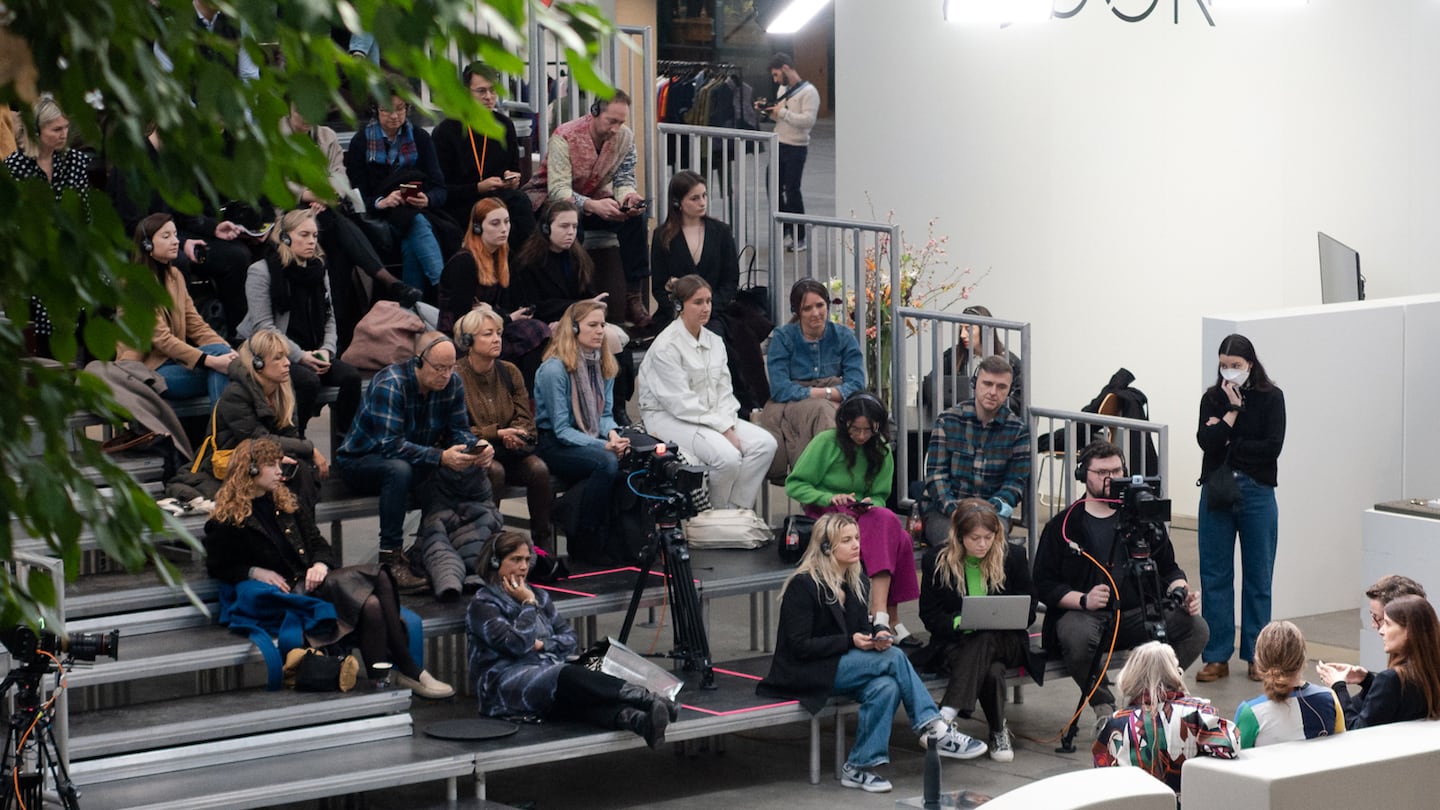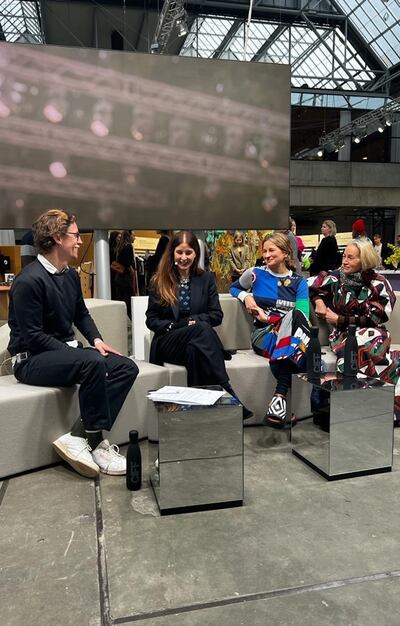
The Business of Fashion
Agenda-setting intelligence, analysis and advice for the global fashion community.

Agenda-setting intelligence, analysis and advice for the global fashion community.

Kicking off the 2022 trade show calendar, more than 500 international brands and thousands of visitors, as well as an array of renowned international editors and buyers from major publications and retailers, visited the Copenhagen International Fashion Fair (CIFF) last week — one of Europe’s longest running and most established tradeshows, attendee figures neared pre-pandemic levels this season.
As part of CIFF’s extensive talk programme this year, designed to educate its community and create opportunities for connection, BoF’s Robin Mellery-Pratt and Alice Gividen discussed the critical need for players within the fashion industry — regardless of size — to come together to meet the challenges of the climate emergency in a custom thought-leadership presentation, How Independent Businesses Can Drive Industry Transformation.
From engaging with fashion’s new co-operative era to the technological tools that can reimagine how brands communicate the provenance of materials and extend product lifecycles, the talk laid out the factual framework on the scale of the issues facing the industry as a result of the climate crisis and on-going disruption. The panel also highlighted areas of positive progress for independent entrepreneurs to consider.
Building on the theme, on Day 2, Lucinda Chambers and Molly Molloy, co-founders of British luxury brand Colville, a brand founded as an antithesis to the fast fashion model, were invited to join a panel to share their personal experiences on the continuing theme of collaboration. Since its inception in 2018, Colville has incorporated elements of upcycled product into its collections, but has more recently launched an accessories line following a small number of considered partnerships with global craft communities. It counts Matches Fashion, Selfridges and Farfetch among its stockists.
Joining them was jeweller Maria Black, who founded her eponymous label in 2010. The pandemic gave Black the opportunity to take stock of her supply chain processes and the practices of the global jewellery and mining industries, in a bid to understand the impacts and forge a pathway to a less harmful industry. Today, her brand has developed and implemented an IMPACT Sourcing Commitment. As part of this impact strategy, Black has chosen to support the artisanal mining communities and has implemented Fairtrade gold into her entire gold jewellery production. Another leg in this strategy has been to discontinue the use of mined diamonds in exchange for lab-grown diamonds.
The panel, Creating Positive Impact Through Collaboration, explored how a business culture of information sharing combined with a willingness to collaborate can incite change and drive positive impact. Below, BoF shares the key takeaways.
Start Somewhere, Anywhere
Sustainable innovation will cost between $20 billion and $30 billion every year for the next decade, according to the Boston Consulting Group’s Financing the Transformation in Fashion 2020 report, and no one is volunteering to foot the bill. The problems are too great for any single entity to solve alone, yet businesses and individuals still face a lack of basic awareness or engagement when trying to collaborate to change.
LC: “You don’t start a company thinking, ‘We’re going to do exactly this, and this is the culture we’ll have,’ but we knew the culture of Colville would be different to traditional luxury houses. The amount of product was not going to be as incessant.
“We look around us all the time and think, ‘What’s not being reused? What’s all around us?’ That comes into the clothes we make, the sets we build — you have to be on ‘receive mode’ all the time. That’s a real passion of ours.”
MM: “We need to encourage suppliers to decrease production minimums, which sometimes can be 150 to 300 metres. This can be impossible for the small companies and just creates warehouses of waste if not all used up. We just heard one supplier here in Italy was instructed by a big luxury house to burn the excess fabric — these things are still happening!
“For us, everything happened organically. What was important from the beginning was upcycling. We upcycled in our first collection and gauged the response from the consumer and that encouraged us to go ahead and carry on. It was an upcycled shell suit from the 90s, which had lots of colour. We usually couldn’t have done it in our collection due to the amount of fabric used. But it had such a great response, so in the next collection, it felt right to add another upcycled piece.”
MB: “A lot of information in the jewellery industry is one-sided. We tend to tell the same story, such as recycled metals, or certified diamonds. I found myself asking, ‘Where does this information come from?’ I couldn’t find anything to support it.
“I decided I really needed to understand the supply chain. While the [industry] understands it downstream, from the factory to the end consumer, the journey from the mine to the factory is one big blur. I spent two months looking into it and compiled a research brief to share with colleagues and the wider industry.
“It was hard work — two months of compiling information and not everyone has the luxury of doing that if you operate in a fast-paced fashion world. That’s why we thought to share this information — we believed it should be for everyone. We suggested and developed a new programme with the Fairtrade Organisation in the UK, allowing brands to use as much or as little Fairtrade gold in their production as their business model allows. We chose 30 percent, but another brand could choose any percent that suits their margin calculation. This small adjustment opens up the gateway to supporting indigenous mining communities socially and environmentally.”

Educating Your Network and Consumers
In BoF’s Sustainability Index, a report which tracks fashion’s progress towards urgent environmental and social transformation, transparency was one of the strongest-performing categories in the index, but despite this, progress towards this foundational goal remains slow.
As the potential to demonstrate progress becomes more important in gaining the trust of fashion consumers —some 43 percent of Gen-Z say they actively seek out companies that have a solid sustainability reputation — information-sharing between brands and consumers is increasingly key.
MB: “If you call an NGO, they are more than willing to talk. I was amazed by the openness and invitations that I got. I spent hours on Zoom in lockdown with associations such as Fairtrade and Fairmined — all were so happy to information-share.
“Realising the help was there, that there was a wealth of people ready to share information, was a great learning experience. When communicating the [findings] with my staff, there was resounding agreement that we would take a hit on our margins. If you’re going to do anything good, fair or responsible, it’s going to cost you money. But you can develop a business strategy that offsets this cost. That’s an important learning.”
MM: “What’s really amazing is the end-customer is really open and they are asking questions. They’re starting to ask for insight into pricing, [like] why a bag should cost a certain amount. That communication has led to sales. We talk to the end-consumer about our collaborations and how they have evolved — it’s been a great pleasure.
“For bigger stores, we know that educating the consumer is difficult. But if we keep repeating the message, and our consumers are willing to listen, that information does land.”
LC: “Consumers’ money is hard-earned. They want to know what they’re spending money on, and they want their clothes to have real longevity. We were always going to make things as sustainable as we can and collaborating to [do so] is one of our biggest pleasures.”
Radical Collaboration and ‘Receive Mode’
Many major brands have promised consumers they will make positive changes, but they cannot hit those goals alone. They need factories, usually owned by third parties, to switch to green energy sources and install new equipment. While brands may push for the upgrades, suppliers say they are often on their own when it comes to paying for them. A more radical approach is required if the industry is to turn its commitments into actions.
MB: “We still have this competition mindset when it comes to Corporate Social Responsibility (CSR) strategies. All brands need to stop thinking about responsible sourcing programmes as a business leg. It’s not enough for two or three brands to do this — it has to become an industry-wide practice.
“Don’t be afraid to reach out and talk to people, even if you get a rejection. On a personal note, anyone can reach out to us, and we will share our findings with other jewellery brands. When you embark on becoming a more transparent and open business, be open yourselves to sharing information. It’s so key we all get on board at the same time, or [the industry] won’t make it in time.
“In order to help other brands make incremental change in a way that suits their business, my team and I suggested and developed a Fairtrade gold sourcing tool with the organisation, which allows brands, is to use as much or as little Fairtrade gold in their production as their busines model allows.”
MM: “We are constantly thinking of new ways we can use our unused fabrics and materials, we created a project using all our leftover yarns and making one-off pieces with an Italian association Manusa that helps reintegrate vulnerable people into society. We should be working on more of these projects as an industry.
“Could we encourage the bigger companies to sponsor the smaller companies with all their waste fabrics? I would be happy to donate our surplus fabric to a young start-up and [it’s] a good way to collaborate. We shouldn’t be frightened of this.
“We are talking to a big company about using their dead stock. This is a great way to alleviate a bigger companies excess. Reach out and aim high — people will be really responsive, even if they don’t want to put their name to it, they are sometimes happy to get rid of stock.
LC: “Collaborating is one of our biggest pleasures. I met an NGO worker at a lunch, who told me about women she worked with in Dakar, making rush mats. She now makes mats for us and supports 16 villages.
“They bring incredible craftsmanship, but we work at their pace. A retailer may ask for X number of units, but that may not be possible, as we keep to the craftswomen’s speed. It’s about always being on ‘receive mode’. Keep talking to people – keep asking questions.
“Never stop asking questions as you never know who you are sitting next to. No connection goes to waste, and you will find the people who will come on the journey with you.”
This is a sponsored feature paid for by CIFF as part of a BoF partnership.
From analysis of the global fashion and beauty industries to career and personal advice, BoF’s founder and CEO, Imran Amed, will be answering your questions on Sunday, February 18, 2024 during London Fashion Week.
The State of Fashion 2024 breaks down the 10 themes that will define the industry in the year ahead.
Imran Amed reviews the most important fashion stories of the year and shares his predictions on what this means for the industry in 2024.
After three days of inspiring talks, guests closed out BoF’s gathering for big thinkers with a black tie gala followed by an intimate performance from Rita Ora — guest starring Billy Porter.